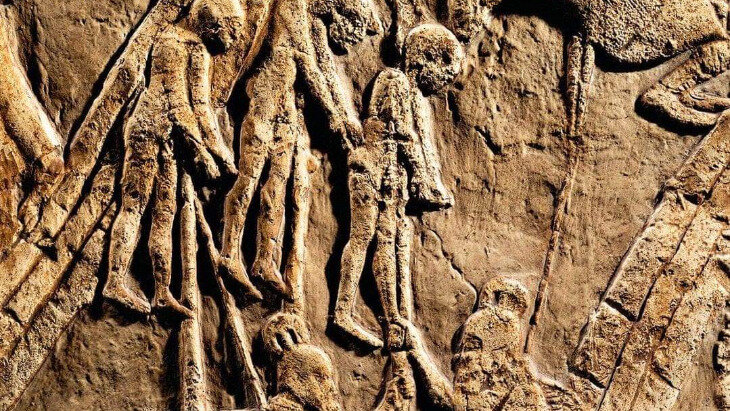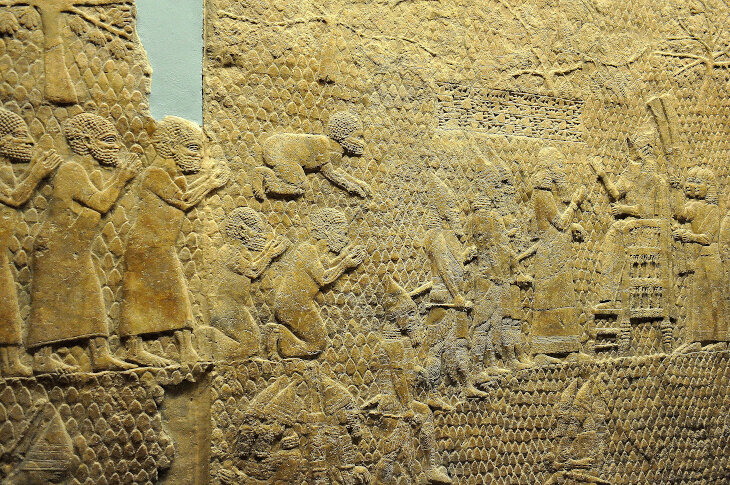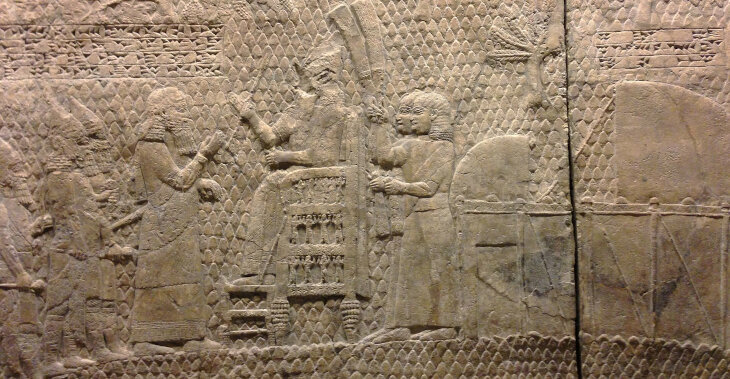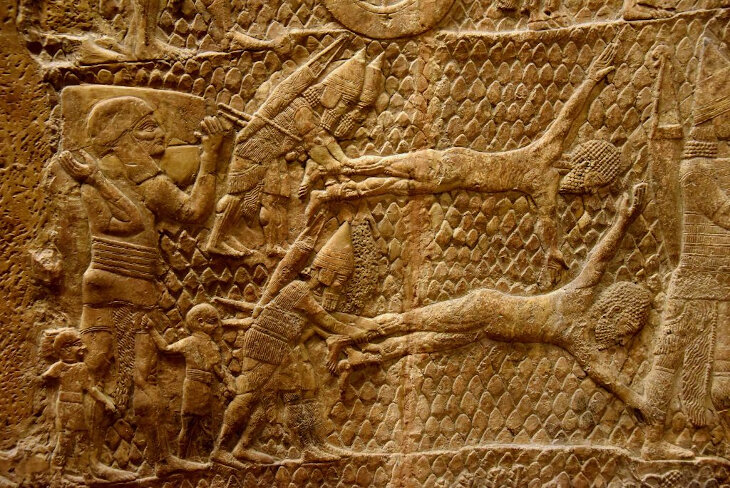 Passover’s Message of Hope in the Aftermath of Oct. 7
Passover’s Message of Hope in the Aftermath of Oct. 7


8 min read
The Lachish Relief graphically portrays Biblical scenes of a 3,000-year-old Jewish calamity.
In 1839, a young English lawyer named Austen Henry Layard quit his job in London. Austen, 22, showed signs of a promising legal career but he longed for adventure. His horseback journey though present-day Turkey, Syria and Iraq would change our understanding of history.
In the Middle East, Austen began trying to excavate sites that he believed were mentioned in the Bible. His first attempt resulted in unearthing a massive 3,000-year-old Assyrian palace filled with exquisitely preserved artwork near the present-day Iraqi city of Mosul.
 Austen Henry Layard
Austen Henry Layard
Austen moved on to another site near Mosul and stumbled upon the ancient city of Nineveh, seat of the fearsome Assyrian King Sennacherib whose terrifying attacks on ancient Judea are documented in the Bible.
King Sennacherib was one of the most fearsome rulers the Middle East has ever known. Ascending to power in about the year 705 BCE, Sennacherib succeeded his father King Sargon II as ruler of Assyria. Neil MacGregor, the Director of the British Museum, calls Sennacherib’s ancient Assyrian empire “the largest land empire yet created” and “the beginning of the very idea of the Middle East as a single theatre of conflict and control.”
Sennacherib ruled a massive area that stretched from Iran to Egypt, yet faced two significant rebellions. The larger one was in Babylon (which would soon steal Assyria’s mantle as the great power in the Middle East). Sennacherib spent much of his early reign fighting Babylonian rebels. He so thoroughly destroyed the city of Babylon that river waters flowed over it, as if its massive buildings and bustling settlements had never existed. Then, in the year 701 BCE, he turned his attention to the Jewish kingdom in the south.
 Sennacherib receiving the submission of the Jews before Lachish.
Sennacherib receiving the submission of the Jews before Lachish.
The tragic story of what happened next is told in the Biblical Book of Kings II. During Assyrian rule, present-day Israel was split into two Jewish kingdoms: the kingdom of Israel to the north, and the kingdom of Judah to the south. Jewish kings resisted Assyrian rule, and the Assyrian empire reacted mercilessly. In 722 BCE, King Sargon II attacked the kingdom of Israel, overrunning it with his soldiers. He slayed many thousands and carted tens of thousands more to settle far-flung areas of the Assyrian kingdom. By the time Sennacherib was crowned, only the kingdom of Judah remained as a Jewish entity.
Lachish was a city in the kingdom of Judah with a very long history. First settled by cavemen before the 31st century BCE, Lachish developed into a prosperous walled city ruled by Canaanite tribesmen and later by Egypt. It was conquered by the Israelites, but fell into ruin until the reign of King David, when building began once again in the town. As the largest Judean city close to the hostile Philistine tribe, Lachish was crucial for the Jewish kingdom’s defense.
 The single inscription which identifies the location depicted in the reliefs reads: "Sennacherib, the mighty king, king of the country of Assyria, sitting on the throne of judgment, before (or at the entrance of) the city of Lachish. I give permission for its slaughter"
The single inscription which identifies the location depicted in the reliefs reads: "Sennacherib, the mighty king, king of the country of Assyria, sitting on the throne of judgment, before (or at the entrance of) the city of Lachish. I give permission for its slaughter"
According to Israel’s Ministry of Foreign Affairs, ancient Lachish “was fortified with a double line of massive mud-brick walls on stone foundations. The main city wall on top of the mound was 6 meters wide, with a sloping glacis (a sloping mound beneath a fort) supported by a revetment wall along the middle of the slope. The city gate, in the southwestern wall, is one of the largest and most strongly fortified gates known of this period. It consists of an outer gate in a huge tower built of large stones which protrudes from the line of defenses. The gatehouse, on top of the mound, consists of three pairs of chambers with wooden doors on hinges…”
In the year 701 BCE, King Sennacherib sent his mighty forces to Judah to subdue the rebellious Jews living there. Judah’s King Hezekiah amassed his own troops, but they were swiftly overwhelmed. “In the fourteenth year of King Hezekiah, Sennacherib king of Assyria attacked all the fortified cities of Judah, and captured them” (Kings II 18:13). City after city fell to Sennacherib: Sidon, Ammon, Ashkelon, Ekron, and Lachish. Sennacherib’s own records of the carnage, carved in stone, survived and are today housed in the British Museum in London:
“Because Hezekiah, King of Judah, would not submit to my yoke, I came up against him, and by force of arms and by the might of my power I took 46 of his strong-fenced cities; and of the smaller towns which were scattered about, I took and plundered a countless number. From these places I took and carried off 200,156 persons, old and young, male and female, together with horses and mules, asses and camels, oxen and sheep, a countless multitude.”
Sennacherib himself made Lachish his base during this conquest. The Bible describes King Hezekiah contacting him there: “Hezekiah king of Judah sent (word) to the king of Assyria, to Lachish….” (Kings II 18:14). Sennacherib demanded a huge tribute from King Hezekiah, and soon negotiations broke down. Sennacherib amassed an enormous army to lay siege to Jerusalem, the capital of Judah.
 Lachish leaders being flayed alive
Lachish leaders being flayed alive
His troops surrounded and besieged the city, but their attack was halted by a mysterious plague. “An angel of God went out and struck down one hundred eighty-five thousand (soldiers) of the Assyrian camp. The rest arose in the morning and behold - they were all dead corpses! So Sennacherib king of Assyria journeyed forth, went and returned, and he settle in Nineveh” (II Kings 19:35-36).
The mysterious plague that struck the Assyrian soldiers was also recorded by Herodotus, a Greek historian of the ancient world:
“As the two armies lay here opposite one another, there came in the night, a multitude of field-mice, which devoured all the quivers and bowstrings of the enemy, and ate the thongs by which they managed their shields. Next morning they commenced their fight, and great multitudes fell, as they had no arms with which to defend themselves…” (Herodotus, The Histories, Book 2, Chapter 141).
In Nineveh, Sennacherib devoted himself to building an enormous new palace for himself. For decoration, he ordered his workmen to build a grisly monument: a giant eight-foot frieze carved from floor to ceiling that depicted, in horrific detail, all the tortures that Sennacherib and his soldiers had heaped upon the conquered, besieged Jews. The panels were so numerous that they stretched across an entire room. Sennacherib chose the destruction of Lachish as the subject to represent the entire conquest of Judah.
Nearly 3,000 years later, Austen Henry Layard excavated Sennacherib’s palace near Mosul. He could scarcely believe his eyes as he uncovered the huge stone reliefs of the siege of Lachish.
He later wrote:
“Here, therefore, was the actual picture of the taking of Lachish, the city as we know from the Bible, besieged by Sennacherib, when he sent his generals to demand tribute of Hezekiah, and which he had captured before their return; evidence of the most remarkable character to confirm the interpretation of the inscriptions, and to identify the king who caused them to be engraved with the Sennacherib of Scripture” (Austen Henry Layard, Discoveries Among the Ruins of Nineveh and Babylon: 1853).
The discovery of the Lachish Relief cemented Austin Henry Layard’s reputation. He returned home to England in triumph, and was later knighted and elected to Parliament. He kept many of the priceless artifacts he’d discovered, and bequeathed them to the British Museum after his death.
 People escaping from Lachish
People escaping from Lachish
Among his gifts to the museum was the Lachish Relief, as the stone carvings of the siege of Lachish are called. They remain in the British Museum to this day, a haunting rendition of one of the worst tragedies in Jewish national history.
British Museum Director Neil MacGregor explains that the Lachish Relief panels “would once have been brightly painted, but even without any color today they are astonishing historical documents - like a film in stone, an early Hollywood epic, perhaps, with a cast of thousands. The first scene shows the invading army marching in, then comes the bloody battle in the besieged town, and then we move on to the dead, the injured and the columns of passive refugees…. As the frieze progresses, wave after wave of Assyrians scale the city walls and eventually overwhelm the resident Judaeans.”
Later scenes show the horrific scenes of Jewish refugees after Sennacherib’s victory in Lachish. “Survivors flee the burning city, carrying what they can. These lines of people, carrying their worldly goods and heading for deportation, must be one of the earliest depictions of refugees that exist.” (Quoted in A History of the World in 100 Objects by Neil MacGregor: 1996).
Despite the passage of time, the cries of the residents of Lachish continue to call out today, recorded in the panels that Sennacherib so ghoulishly ordered built.

Before reading this article, my only knowledge of Sennacherib was from Lord Byron's beautiful poem "The Destruction of Sennacherib." The Biblical reference is in the book, too, and I went to read it. I still have my English Lit text, and love this poem so much that there is a bookmark on the page! I wonder why G-d waited so long to destroy this terrible tyrant. I'll have to get out my Bible and read the earlier passages in 2 Kings.